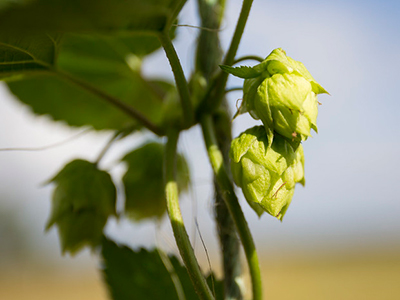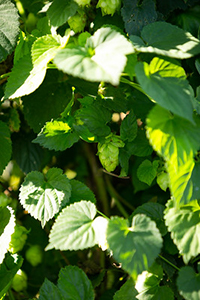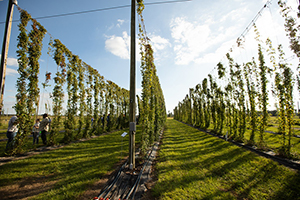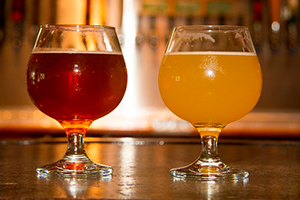
Hops "cones" grow on the climbing vines of Humulus lupulus. Credit: UF/IFAS
Hops
Hops are famous as the ingredient that adds bitterness and flavor to beer. They're native to northern regions of Europe, Asia, and the Americas. But did you know that hops can be grown in Florida, too?
While it's true that yields in the Pacific Northwest are significantly higher than our yields here in the South, hops have been grown successfully here in the Sunshine State. And UF/IFAS researchers are working on breeding improved Florida varieties even as you read. But don't let the wait for new varieties slow you down. Add hops to your garden and you can enjoy this unique crop this year.
Characteristics
Hops (Humulus lupulus) are a member of the botanical family Cannabaceae. They are a perennial, herbaceous, climbing plant. They are commonly grown for their cones (or "strobiles"). Although generally grown in USDA Hardiness Zones 4-8, research has shown that hops can be gown as far south as 9B. Since flowering in hops is triggered by shortening days, hops grown in Florida often flower prematurely.

Trellising hops' vines will improve yields and make harvesting a breeze. Credit: UF/IFAS
Humulus lupulus is dioecious, meaning it has separate male and female plants. Male plants produce male flowers and pollen. Female plants produce female flowers, which develop into cones. The plants grow best in 16 hours of sun, available only above 35 degrees latitude. In Florida the latitude is not above 31 degrees, meaning that our maximum day length is below 15 hours.
Hops' stems twine rapidly up a trellis, sometimes growing as much as 12 inches in one day! Trellising is necessary as mature plants can reach a height of 18-25 feet. They grow their fastest during the lengthening days of spring and summer. Cones are usually harvested in late summer and early fall. Their bitter flavor is prized by beer brewers but hops are also an ingredient in some herbal teas and soft drinks.
Planting and Care
While UF/IFAS scientists are working on varieties adapted to Florida's short days, Floridians can still include hops in their home gardens. Yields will be lower, but so will final plant height. This is good news, since homemade trellises rarely reach 18 feet. Yields should be more than enough for a home brewer.
Hops are propagated by rhizomes, usually purchased through online retailers. Order as early in the year as possible for a March/April planting date. The sooner you plant, the longer your crop will have to grow before the days begin to shorten and flowering begins. New stems often take 2-3 weeks to emerge. Don't be discouraged by their slow start.
Plant rhizomes about one inch deep in the soil, in full sun, at the base of a trellis or fence. Hops are drought tolerant once established but do best with some supplemental irrigation. Hops prefer well-drained, humus-rich, sandy loam soils. Ideal soil pH for this crop is between 6 and 7. If you plant your hops in rows, orient the row north-south to take advantage of the sun's movement from east to west across the sky. Commercially, hops benefit from a balanced, slow-release fertilizer applied in spring and summer.

Tall trellises of hops at the UF/IFAS Gulf Coast Research and Education Center in Balm. Credit: UF/IFAS
Although hops prefer a mean annual temperature at or below 70 F, they will survive Florida's hot summers. Winter freezes will cause leaf loss and dieback. Prune them back and the stems will sprout again from the ground in the spring.
Root-knot nematodes can damage plantings of hops and significantly reduce yields. If you have observed nematode damage in your landscape, consider planting hops in large containers (about 20 gallons) or raised beds. Early research suggests that the cultivar 'Cascade' is resistant to nematodes and produces relatively high yields in Florida. Hops can also be grown as an annual crop if the nematode damage is too extensive.
Mites, downy mildew, and powdery mildew are also common pest and disease problems. Plant hops in a location with good airflow to reduce the risk of fungal disease.
For more information about adding hops to your garden, contact your county Extension office.

Even with reduced yields, a hops crop large enough for home hobby brewing is possible in Florida. Credit: UF/IFAS

